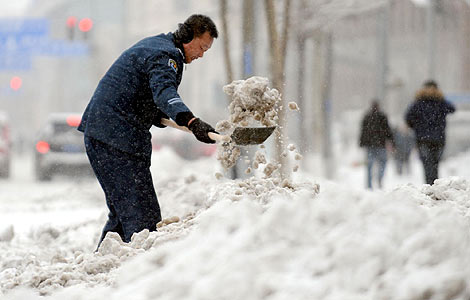
TOKYO - Almost a quarter of Japanese manufacturers are rethinking their investment plans in China and some may shift future production elsewhere after the spike in tensions between Asia's two largest economies.
The sentiments were expressed in a Reuters Corporate Survey released on Wednesday and in interviews conducted in recent weeks with executives in industries ranging from electronics to apparel manufacturing.
The concerns suggest the recent rift between China and Japan over Diaoyu islands could mark the end of a boom that has played out over two decades in which Japanese companies have emerged as the most active source of outside direct investment in China.
Over 20,000 Japanese firms invested in the Chinese mainland as they looked to take advantage of low production costs and then China's potential as a surging market for everything from cars to cosmetics.
Now, sentiment has turned. When asked if their attitude toward using China as a production hub over the medium term had changed, 37 percent of Japanese companies surveyed said they had grown more cautious.
Almost half of Japanese manufacturers said they expected to see lower sales in the current fiscal year. In response to a separate question, 24 percent said they were considering delaying or reducing planned investment in China. Eighteen percent said they were considering shifting production to other countries.
The survey allowed companies responding to pick more than one choice to describe the impact of the island dispute on their business, meaning there could be some overlap between the group of manufacturers considering cutting investment and those looking to other markets outside China as future production hubs.
"China is very convenient, but gradually that convenience has been fading," Yoshihisa Ejiri, 65, president of clothing chain Honeys Co told Reuters.
The Reuters survey of 400 Japanese companies took place between Oct 1 and Oct 17. A month earlier, almost 60 percent of firms in the survey said they expected little to no fallout from the strains with China. Companies were not asked if they were considering delaying or reducing planned investment in China in that poll.
Southeast Asia an alternative?
The 267 Japanese companies that responded to the Reuters Corporate Survey did so on the condition they not be named.
In separate interviews, several executives, including Ejiri, the Honeys president, said they expected to point new investment to Southeast Asia and largely untapped markets like Myanmar.
Ejiri is determined to reduce his company's reliance on China, where Honeys now sources 90 percent of the clothing it sells. In the first step to diversify, Honeys began making skinny jeans - a hot-selling item this summer - in Myanmar.
Tyre maker Toyo Tire & Rubber Co has also said it is considering shifting investment aimed for China to Malaysia, where it is building a plant and owns a local firm.
Analysts and executives said the shift from China would come first for low-margin businesses where labour costs are crucial, like clothing and household electrical products.
For manufacturers that depend on sales in China, like Japanese car and auto parts makers, there is no choice but to slow production and hope the anti-Japanese sentiment subsides and inventories can be sold down, they said.
"Things made in China for the domestic market will stay, but for things made in China to export, the advantages, starting with labour costs, are declining," said Isamu Wakamatsu, a Southeast Asia specialist at the government-affiliated Japan External Trade Organisation.
For nearly a decade, Japanese business strategists have been talking up a "China Plus One" strategy - a policy of managing risk by locating plants and facilities in China and one other Asian nation.
Go to China, or go bust?
Honeys started production in China in the early 1990s, a time when Japanese firms led by consumer technology leaders like Panasonic, NEC Corp and Sharp Corp were rushing in.
"China is vast with a huge population and a strong infrastructure, beginning with the cotton-spinning. It's all there. For Japanese fabric-makers, the choice has been going bankrupt or move to China," said Ejiri.
Over time, the world's two biggest economies after the United States grew to complement each other, with China becoming "the world's factory" and Japan supplying many of the components needed for assembly. Two-way trade grew 14 percent to a record $345 billion in 2011.
Interest in the "China Plus One" strategy starting picking up after the outbreak of the SARS disease that sharply affected China for several weeks in 2002. It was a regular topic in Japanese business circles in 2005, following a wave of anti-Japan demonstrations in China that year.
For Honeys, which has more than 800 outlets in Japan and over 500 in China, rapidly rising wages in China had become a concern even before the recent tensions. When Honeys started in China in 1991, workers making its clothing made about $65 a month, about one-seventh of what they earn today.
The territorial dispute between Japan and China added a new flashpoint. When workers returned to plants run by Canon Inc and Casio Computer Co last month after the factories were shuttered, they also demanded higher wages, company representatives said.
"Labour costs (in Myanmar) are one-fifth of what China is," Ejiri said, adding that Myanmar also has no export duties for clothing, unlike China.
For 2011, Japanese direct investment in the Southeast Asian region surpassed China by a margin of almost 50 percent, according to data from Japan's finance ministry.
Experts and company executives say it will take years before Southeast Asia can compete with China on factors that are harder to measure than payrolls, like a large pool of skilled talent and a developed network of suppliers.
Component maker Yamaichi Electronics Co found that out in 2010 when it built a new production line for connectors in the Philippines, to help it hedge its risk in China.
"In Shenzhen, all electronics parts are in the area. Japan makers, China makers, everything you need is right there. It's not like that in the Philippines," said a Yamaichi executive who spoke on the condition he not be identified because of the sensitivity of the issue.
Ejiri, whose Myanmar plant is operating at 60 percent of capacity, agreed. He said he expects it will take a decade for Southeast Asia to match China for efficiency, but he is prepared to be patient. The long-term goal is for Myanmar to account for 20 percent of Honeys' production.
"The buttons, the zippers, only China can do that cheaply," he said. "Since the materials are there, the goods end up getting assembled there, and that will take some time to change."
The survey was conducted for Thomson Reuters by Nikkei Research. Target companies were split evenly between manufacturing and non-manufacturing with 60 of those in retail and wholesale and another 55 in electronics and precision equipment. Not all companies responded to every question.







